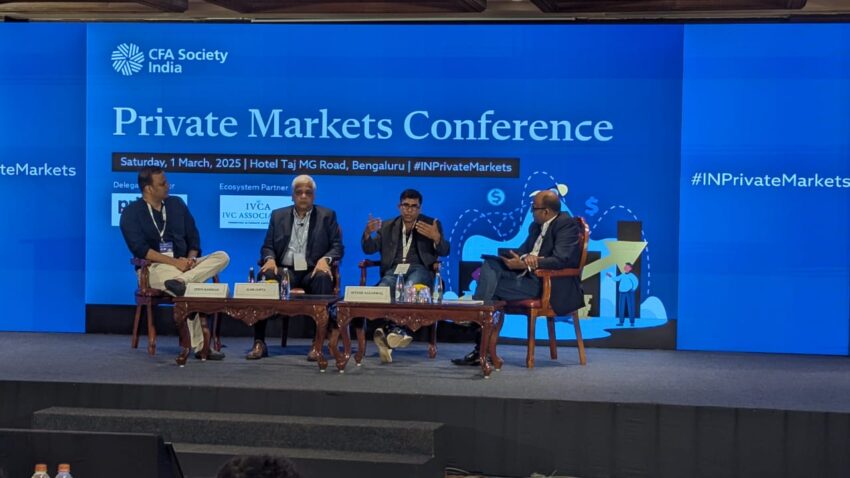Until a few years ago, India was primarily seen as a market for investment, but exits remained a challenge. Over the past five to seven years, public markets have emerged as a viable exit route for many General Partners (GPs), and strategic exits have also gained traction. However, liquidity constraints still pose challenges, prompting the rise of secondary funds, including direct secondary funds and GP-led restructurings, as essential tools in India’s evolving private market.
On similar lines, PrivateCircle founder Krishna Saraswati recently moderated a panel discussion on the “Emergence of Secondaries” at Private Market Conference organised by CFA Society India. The panelists included Zerin Rahiman, Director at IndigoEdge; Alok Gupta, Partner, Head of India at Foundation Private Equity; and Nitesh Aggarwal, Vice President at MSPL Limited (Baldota Family Office), who shared their perspectives on how secondaries are shaping India’s private market landscape.
The Growing Relevance of Secondaries
Expanding on the factors driving secondaries in India, Zerin Rahiman, Director at IndigoEdge, highlights that India’s public markets are structurally strong—well-regulated, democratic, and the third-largest by market capitalization. The cost of listing is relatively low, enabling companies with a ₹500-2,000 crore market cap to go public. Additionally, GIFT City is facilitating foreign capital inflows, further strengthening market dynamics.
With late-stage funding drying up, many tech companies are now prioritizing profitability. Investors who expected exits by 2024 are now facing extended timelines up to 2026-27 but cannot afford to wait indefinitely. As a result, there is a growing need for investors who can acquire positions from those exiting due to regulatory or practical constraints, particularly in high-quality companies poised for liquidity in the next three to five years.
Alok Gupta, Partner, Head of India at Foundation Private Equity, notes that India’s private equity and venture capital markets are beginning to mirror global trends in liquidity solutions. Unlike mature markets like the US and Europe, where secondaries have developed over decades, India is now seeing their emergence. Given that most PE/VC funds in India are closed-ended, structured liquidity solutions are becoming increasingly necessary. Regulatory developments, such as stricter guidelines on fund closures, are further accelerating this shift.
Challenges and Opportunities in Fund Transitions
Despite the growing momentum, India still faces unique challenges in secondary transactions. Nitesh Aggarwal, Vice President at MSPL Limited (Baldota Family Office), highlights that while their India-focused investments have outperformed those in the US, the country still lacks a strong M&A culture. Unlike in the US, where major players like Google frequently acquire startups, Indian companies have traditionally preferred building over buying. This has created hurdles in fund-to-fund transitions, where Series A investors struggle to exit to Series B investors, leading to liquidity crunches and pushback from institutional investors.
Over the past eight years, Baldota Family Office has deployed around $20 million across 43 funds in India and the US. Interestingly, he noted that for Baldota Family Office both internal rate of return (IRR) and distribution to paid-in capital (DPI) in India is higher than the US funds.
The Role of Continuation Vehicles and Regulatory Influence
According to Alok Gupta, GPs prefer to hold onto their portfolios and often require additional time beyond fund life extensions. This makes continuation vehicles (CVs) attractive, where the incumbent GP manages assets for new Limited Partners (LPs), though this can create conflicts of interest. Regulatory constraints have limited exit options, forcing GPs to explore liquidity solutions earlier. As fund closures approach, GPs are increasingly considering selling assets or marking down portfolios to balance Distributed to Paid-In Capital (DPI) and total value to paid-in (TVPI) metrics. Larger funds managing extensive portfolios may spin out CVs under SEBI’s AIF norms, though exiting underperforming companies remains a challenge.
The evolving regulatory landscape in India is playing a significant role in shaping investor behavior. Many large fund managers, overseeing billion-dollar portfolios, now conduct dedicated weekly exit meetings, reflecting the urgency of securing liquidity. This has led to the emergence of new fund structures designed to facilitate exits—either by acquiring stakes at a discount or structuring innovative portfolio carve-outs. Unlike previous IPO and strategic exit cycles, these new mechanisms offer alternative liquidity pathways. The key question is whether this will extend the IPO cycle, encourage more strategic acquisitions, or simply provide an interim liquidity solution.
Conclusion: Secondaries as a Critical Asset Class
With IPO cycles occurring annually and strategic exits still in their nascent stages, much of the liquidity for GPs will need to come from restructuring and secondaries. As Alok Gupta notes, while secondaries may not always be the perfect solution, they are increasingly seen as a viable, albeit partial, answer to India’s liquidity challenges. Regulatory interventions are actively shaping fund manager-LP dynamics, ensuring structured exit pathways. For investors, secondaries are emerging as a crucial asset class—offering pricing advantages, regulatory-driven arbitrage, and new opportunities to navigate India’s maturing private market ecosystem.

